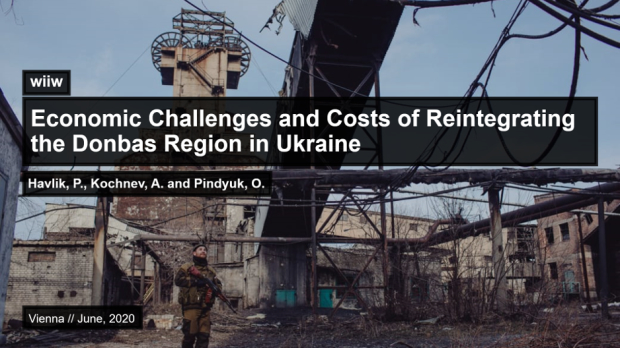Ukraine: reconstruction of Donbas will cost at least USD 21.7 billion or 16% of Ukraine’s GDP
25 June 2020
A new wiiw study provides the first comprehensive calculation of the costs of the conflict and outlines a recovery plan for the region.
photo credit: istock/Diy13
The wiiw study estimates the minimum costs of reconstruction at USD 21.7 billion. These costs include damage to physical capital (44%), human capital expenditures (40%), and mitigation of environmental threats (16%). The direct damage caused by violent actions is not the most significant cost driver in the long run. 42% of the restoration costs can be attributed to the disruption of business continuity and the degradation of state capacity that accumulated over years of inaction.
The estimated reconstruction costs are too great to be covered by the Ukrainian budget alone. They equal more than 40% of the annual revenues of the Ukraine’s state budget or 16 percent of the GDP in 2018. The authors therefore recommend various sources of finance, including both court-ordered compensations and voluntary contributions by Russia. However, international finance appears to be the most viable option conditional on stability of financial markets.
Although the study assesses that the COVID-induced global recession will increase the reconstruction costs, it highlights the potential positive effects in the peace settlement process. With the burden of the COVID-induced economic crisis growing, the opportunity costs of the conflict and support of the satellite states will increase for the Russian elites. Therefore, a prolonged recession will increase the likelihood that the Kremlin will adopt more accommodative foreign policy in the coming years.
Against this background, the wiiw study proposes a reconstruction plan for the post-war period. First, the Ukrainian state should ensure personal security of the local population in Donbas by demining the region and eliminating environmental threats. This will bring immediate results and boost the positive sentiment of the peace process.
Second, the Ukrainian government should address the causes of the ongoing humanitarian crisis. This would require a massive state investment in rebuilding of the critical infrastructure and a large-scale reallocation program for displaced population supported by the cash assistance program.
Third, the Ukrainian state should lay a sound foundation for the sustainable long-term economic growth in the region. A clear framework for resolving the property rights disputes in the post-war period and preferential investment schemes are critical to boost the local domestic and foreign investment.
Finally, the Ukrainian government should achieve the post-war resilience by assuring the legitimacy of the peace process. It is necessary to support administrative capacities and political engagement in Certain Areas of the Donbas and Lugansk Regions (CADLRs) to assure that the local population has effective peaceful means in the Ukrainian political process to address local economic and political needs.
While the coordination of a reconstruction program should be left to the Ukrainian authorities to assure responsibility and process ownership, the authors recommend to draw upon existing institutional arrangements of technical assistance to Ukraine – such as the Strategic Advisory Group for Supporting Ukrainian Reform (SAGSUR) or the Ukraine Reform Architecture (URA) programme, – and to establish a small high-level expert supervisory body to audit the reform implementation process.

